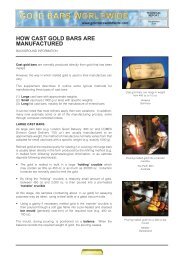Indian Gold Book:Indian Gold Book - Gold Bars Worldwide
Indian Gold Book:Indian Gold Book - Gold Bars Worldwide
Indian Gold Book:Indian Gold Book - Gold Bars Worldwide
You also want an ePaper? Increase the reach of your titles
YUMPU automatically turns print PDFs into web optimized ePapers that Google loves.
WHOLESALING TO DOMESTIC BULLION DEALERS<br />
Although the banks (combined) wholesale bullion to more than 200 secondary tier dealers around India, the<br />
bulk of their business is transacted through less than 50 major customers.<br />
Large orders can exceed 1000 TT’s. The minimum order quantity ranges between 50 - 100 TT’s.<br />
All banks require cleared payment in full prior to delivery. While Public Sector Banks will normally accept cash in very large<br />
quantities, Foreign Banks generally insist on cheques. Typically, bank customers retain or lodge funds in their bank account<br />
prior to placing an order.<br />
Bank prices are normally based on the prevailing US dollar gold price (converted by the bank to rupees) quoted by the<br />
international dealer that has provided the consignment stock used to supply the customer.<br />
Timing as regards fixing the price can vary.<br />
BANKS<br />
Some banks will sell small quantities at a price fixed each morning by the <strong>Gold</strong> Cell HQ and communicated to its <strong>Gold</strong> Cell<br />
branches. In a volatile market, however, the price would be changed during the day.<br />
For larger quantities, all banks fix the price immediately in consultation with the international supplier of the relevant<br />
consignment stock, provided that the customer has sufficient funds in a bank account to act as a deposit, and full payment<br />
is received within 2 days.<br />
Alternatively, the bank agrees to allow the price on an order to remain “unfixed” for up to 5 calendar days. The customer<br />
pays a deposit of 105 - 110 %. Within 5 days, the customer can then fix the price at the prevailing gold price.<br />
In some cases, for very large quantities, the bank will also act as a “postman” on behalf of a major customer. The customer<br />
deals directly with the international dealer, the bank acting as the conduit through which the order is placed, delivery<br />
arranged, and payment made.<br />
JEWELLERY FABRICATORS<br />
Although banks do sell bullion to major domestic fabricators, they focus on export fabricators - whose gold<br />
usage has grown to around 50 tonnes annually.<br />
Kilobars are popular among export fabricators, as their fabrication units are large relative to those servicing the domestic<br />
market, and they are able to loan these larger bars at “unfixed” prices during the period of jewellery fabrication.<br />
4 banks offer a gold loan service to export fabricators (with 3 more planning to do so), while 4 banks provide a small<br />
service for domestic fabricators. The minimum loan quantity is generally 1 kg. The current maximum loan period can be<br />
360 days (180 days plus another 180 days after export), while the minimum can be as low as 15 days.<br />
RETAILING TO THE PUBLIC<br />
Only 2 banks retail TT’s to the public, and then through only a few of their <strong>Gold</strong> Cell branches.<br />
Corporation Bank. TT’s only. Limited to 4 branches in South India: Cochin and Kozhikode (Kerala), Mangalore and Udipi<br />
(Karnataka).<br />
State Bank of India. Apart from TT’s, it is the only bank to retail small minted bars: 5 g, 10 g and 20 g. Retailing is<br />
limited to a small number of branches.<br />
The activity of banks is inhibited by the time and paperwork required to complete a retail transaction, and the legal<br />
requirement that - for transactions above Rs 50,000 - the customer is required to provide personal identity documents and/or<br />
make payment through a bank account.<br />
GOLD DEPOSIT SCHEME<br />
The Reserve Bank of India has authorised 6 banks to accept gold deposits from the public. 4 were active in<br />
2001.<br />
This scheme is covered in a separate section. In summary, the minimum deposit is typically 200 g. Deposits are lodged<br />
over 3 - 7 years. Annual interest payments are around 3 - 4 %. Although the service is available through 134 bank branches<br />
in 55 cities, few branches have received significant deposits.<br />
FORWARDS MARKET COMMISSION<br />
In May 2002, the Forwards Market Commission (FMC) announced that it would be recommending the removal of gold from<br />
the list of commodities banned under the Forward Contracts Regulation Act, 1952.<br />
AN INTRODUCTION TO THE INDIAN GOLD MARKET 63

















